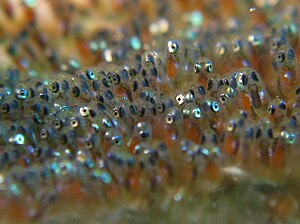
Back Kuit Afrikaans Frega AN سرء Arabic Nerštva BAT-SMG Mrijest BS Laich German Frajado Esperanto Freza Spanish Kudemine Estonian Errunaldi Basque

Spawn is the eggs and sperm released or deposited into water by aquatic animals. As a verb, to spawn refers to the process of freely releasing eggs and sperm into a body of water (fresh or marine); the physical act is known as spawning. The vast majority of aquatic and amphibious animals reproduce through spawning. These include the following groups:
- Bony and cartilaginous fishes (sharks, rays, etc.)
- Crustaceans (such as crabs, shrimps, etc.)
- Mollusks (such as oysters, octopus, squid)
- Echinoderms (such as sea urchins, sea stars, sea cucumbers, etc.)
- Amphibians (such as frogs, toads, salamanders, newts)
- Aquatic insects (such as dragonflies, mayflies, mosquitoes)
- Coral, which are living colonies of tiny, aquatic organisms—not plants, as they are sometimes perceived to be. Corals, while appearing sedentary or botanical by nature, actually spawn by releasing clouds of sperm and egg cells into the water column, where the two mix.
As a general rule, aquatic or semiaquatic reptiles, birds, and mammals do not reproduce through spawning, but rather through copulation like their terrestrial counterparts.
Spawn consists of the reproductive cells (gametes) of many aquatic animals, some of which will become fertilized and produce offspring. The process of spawning typically involves females releasing ova (unfertilized eggs) into the water, often in large quantities, while males simultaneously or sequentially release spermatozoa (milt) to fertilize the eggs.[1][2][3]
The fungi (mushrooms), are also said to "spawn" when they release a white, ‘fibrous’ matter, forming the matrix from-which they grow.[citation needed]
There are many variations in the way spawning occurs, depending on sexual differences in anatomy, how the sexes relate to each other, where and how the spawn is released and whether or how the spawn is subsequently guarded.
- ^ Spawn Archived 2014-11-29 at the Wayback Machine Fishbase Glossary. Retrieved 3 February 2011.
- ^ Spawning Archived 2013-06-21 at the Wayback Machine Fishbase Glossary. Retrieved 3 February 2011.
- ^ Gametes Archived 2013-09-15 at the Wayback Machine Fishbase Glossary. Retrieved 3 February 2011.
© MMXXIII Rich X Search. We shall prevail. All rights reserved. Rich X Search